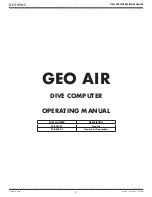
Chapter 13 Infrared Spectroscopy Tutorial
13-4
Speed and Frequency of the Wave
Velocity, V, of infrared waves in air is approximately the speed of light in a vacuum (c or
3 x 10
8
m/s). Whereas the velocity is expressed in distance travelled per unit of time,
frequency measures how many waves pass a given point in a period of time. It is
represented by the Greek letter Nu (
ν
) and expressed in cycles per second or Hertz (Hz).
Thus the frequency equals the velocity divided by the wavelength or
ν
= c/
λ
.
Wavenumber
A second unit of frequency used particularly in the optical regions of the spectrum
(ultraviolet, visible, infrared) is the wavenumber in cm-1, or cycles per centimeter.
Wavenumber is represented by the barred Greek letter Sigma (
σ
). This unit is the
reciprocal of wavelength, but unlike wavelength, it has the advantage of being linear with
values measuring the energy of waves.
The following relationship simplifies conversions:
σ
(cm
-1
) = 10
4
/
λ
(
μ
m). That is, divide
the wavelength (
μ
m) into 10,000 to get the corresponding wave number or divide the
wavenumber into 10,000 to get the wavelength.
ATOMS AND MOLECULES IN MOTION
The analysis of chemical compounds involves identifying both the type of molecules that
comprise these substances (qualitative analysis) and the quantity of molecules present in
a given sample (quantitative analysis). The SapphIRe Analyzer does both. It identifies
quantities of known gases in the atmosphere and determines how much of those
substances (their concentration) is in the sample. It does this by sending a beam of
infrared energy at a selected wavelength through a sample of the substance and by
measuring how much infrared energy gets through the sample. This section explains why
this technique works by examining how atoms move and absorb energy.
Molecular Vibration
All substances are made up of atoms and molecules. Molecules are made up of two or
more atoms held together by electrical forces to form chemical bonds. All molecules are
dynamic, which means they are always in motion. One type of molecular motion is
caused by the vibration of the atoms where they are bonded. These bonds can stretch or
wag back and forth. The degree of molecular vibration or movement depends on the
atoms, their bonds, and the amount of energy available. This motion is natural and occurs
all the time. When a group of molecular atoms stretches or wags back and forth, it does
so at a particular frequency.
Содержание MIRAN 205B Series
Страница 4: ......
Страница 14: ......
Страница 40: ......
Страница 54: ......
Страница 96: ......
Страница 102: ......
Страница 108: ......
Страница 112: ......
Страница 118: ......
Страница 122: ...Chapter 13 Infrared Spectroscopy Tutorial 13 2 Figure 13 1 Electromagnetic Spectrum ...
Страница 142: ......
Страница 170: ......
Страница 196: ......
Страница 202: ......
Страница 210: ......
















































